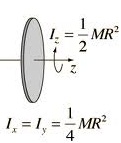Determine the centroidal moment of inertia:
Determine the centroidal moment of inertia of a thin flat disc shown in Figure which is having a mass m kg. By using the parallel axis theorem, extend the result of cylinder of radius a and height h.

Solution
We let the disc made up from rings of varying radius r and thickness dr as illustrated in the figure. The mass of each such ring per unit length shall be m¯ dr . The moment of inertia of this ring can be written as if dm = mass of one such ring then dm = 2πrdr m¯ .
=2 π m¯ a 4 /4
= π a 2 m¯ .( a2/2)
Substituting m = π a 2 m¯ , total mass of the disc, we get
I zo= m .(a2/2)
and
= I xo = Iyo = (1/ 4) ma2
and radius of gyration
kxo = kyo = (½) a
The moment of inertia of the cylinder of Figure (b) about the axes x, y, z may be calculated by extending the above results. The cylinder may be imagined to consist of thin discs of thickness dz.
Suppose γ = unit mass/volume
The total mass of the disc dm = π a 2 dz . γ . The moment of inertia of the disc about its own centroidal axes shall be
I zo = 1 dm . a 2 = 1 π γ a 4 dz
I xo = I yo = (1 /4)π γ a 4 d z
Using parallel axes theorem, the moments of inertia of the disc around the axes x, y,
z are found as
I z = ∫ (½ ) π γ a 4 dz
I x = I y = ∫(1/4) π γ a 4 dz + π γ a 2 z 2 dz
Integrating between the limits
z = - (½) h to z = + (½) h
gives,
I z = (γ π a 4 h )/2
I x = I y = (¼) γ π a4 h + (1/12) γ π a2 h
The total mass of the cylinder m = γ π a 2 h , so the above results may be written as
I z = ma2/2 , I x = I y = (ma4/4) + ( 1/12) mh 2
A sphere is having a radius R and mass m. calculate the moment of inertia about its diameter.